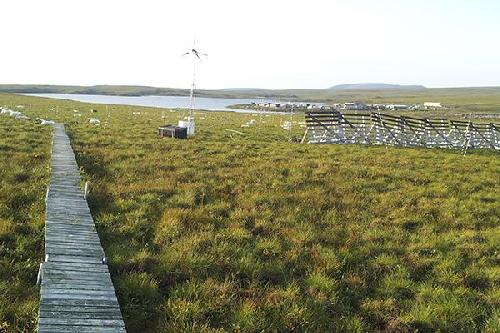Neil Sturchio, professor and chair of the University of Delaware's Department of Geological Sciences, is exploring how the thawing of permafrost, a subsurface layer of soil that remains mostly frozen throughout the year, affects vegetation and the carbon cycle in the Toolik Lake area of the Alaska's North Slope.
"There is a lot of carbon frozen in the Arctic soil's permafrost layer. If this all thaws out, prevailing thought is that the carbon in the soil could be released to the atmosphere and potentially accelerate global warming," said Sturchio.
Climate models predict 25-50 percent more precipitation in the Arctic region by the end of the century, mostly as fall and winter snow. However, extra snow can also mean extra moisture during warmer seasons like spring and summer.
 University of Delaware snow fence experiment at the Toolik Field Station, North Slope, Alaska. Credit: University of Delaware
University of Delaware snow fence experiment at the Toolik Field Station, North Slope, Alaska. Credit: University of Delaware
In 2012, Sturchio and colleagues from several universities conducted a study to determine whether methane and carbon dioxide production in Arctic soils are affected by precipitation, mainly snow accumulation.
Specifically, they studied the long-term effects of projected changes in snow accrual on the methane emissions from moist acidic tundra, which covers over 25 percent of the Alaskan Arctic.
Snow fence experiment
During fieldwork, the scientists used an existing snow fence that had been in place for 18 years to explore what changes in average snow accumulation might mean for the Toolik Lake area. The researchers hypothesized that increased snow accumulation would result in wetter and warmer soils, greater thaw depth and an increase in the abundance of shrubs and tall, grass-like plants called sedges. They also predicted that these soil conditions would lead to increased methane emissions.
Typical winter snowfall depth in the area is about one foot. The snow fence, which stands approximately 9 feet high by 200 feet long, was built perpendicular to the wind direction so that snowdrifts would form behind the fence. This allowed the researchers to mimic various snowfall accumulations for the region, from below normal to average to much higher levels of winter precipitation.
In summer 2012, the researchers established four research plots and took biweekly soil measurements and soil gas samples during the growing season from late May through August. They monitored soil temperature and gas compositions at 10, 20, 35 and 50-centimeter depths; water moisture; oxygen saturation; the amounts and carbon isotope ratios of methane and carbon dioxide; and the thickness of unfrozen ground, known as thaw depth. They also characterized the plant species at peak season.
Snow blanket means longer growing season for plants
As they reviewed the data, the researchers discovered that in areas with increased winter precipitation, the ground didn't freeze as deeply because the snow acted like a blanket, keeping the ground warmer than normal.
Their findings showed that higher snow accumulations resulted in increased soil temperatures and a deeper thawing of the permafrost, which, in turn, resulted in increased microbial activity, increased melting depth and more water content in the soil that led to increased production of methane and more plant growth.
In areas with reduced snow accumulation, however, the soil acted as a methane sink because of enhanced activity of methane-oxidizing bacteria.
The study results suggest that the amount of methane fluctuation was primarily in response to changes in the amount and type of vegetation present, as well as the temperature and moisture of the soil, rather than in how much carbon was in the soil.
When the snow melted, scientists noted a longer growing season for plants and shrubs. In areas with higher snow, the soil also collapsed when the ice that was occupying the soil's pore space melted, causing depressions in the ground.
"It affected more than just the amount of methane produced, it changed the landscape and the types of plants that grew there. We started seeing woody plants -- dwarf trees like birch and other shrubs -- instead of just moss, lichens and grass. This is something you could predict would happen under climate change," Sturchio explained.
More work is needed to better understand the interactions between soil and vegetation processes that affect the release of methane and to determine whether or not the Arctic tundra will act as a significant methane source or methane sink in the future.
"It's safe to say a lot of things are changing in the Arctic. But depending on where you go, the climate change effects are somewhat different," Sturchio said.
The researcher team recently published their findings in the journal Global Change Biology.
source: University of Delaware